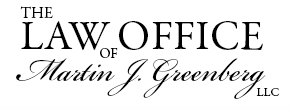June 27, 2017
Ethical Issues in Sports & Entertainment Brought to you by the National Sports Law Institute and Summerfest
by Martin J. Greenberg
Table of Contents
- Title Page
- Table of Contents
- Competent Representation
- Competence
- Milwaukee Bucks
- Why NBA teams are increasing in Value
- BMO Harris Bradley Center
- The NBA’s Ultimatum
- Financing Techniques discussed to create a new Bradley Center
- Bucks Financing Private Contributions
- Bucks Financing, Cont. – Public Contributions
- Breakdown of Public Contribution – City of Milwaukee
- Breakdown of Public Contribution – County of Milwaukee
- Breakdown of Public Contribution – State of Wisconsin
- Breakdown of Public Contribution – Wisconsin Center District
- Arena Lease, Management and Operations Agreement
- Management Control – Miller Park
- Cost Overruns pursuant to Arena Financial, Funding and Construction Funds Escrow Agreement.
- Non-Relocation Agreement
- The Public-Private Partnership at Work
- SCR 20:4.1 Truthfulness in Statements to Others – Stadium Debate
- Taxpayers participate in the cost of sports facilities
- Atlanta Falcons’ Mercedes Benz Stadium – What $1.4 Billion Buys
- Sports Pork
- Taxpayer’s Bill of Rights
- Stadiums are a part of our community and deserve funding
- Sports.comm
- Titletown
- Referendums may not necessarily work.
- Don’t fund it and they will go.
- Stadium Debate – True Economic Cost of Stadium Financing
- Stadium Debate – Municipal Entitlement Fee
- Conclusion
Competent Representation
- Competent Representation is defined by the Wisconsin Supreme Court rules Ch. 20:1.1 as requiring the legal knowledge, skill, thoroughness and preparation reasonably necessary for representation.
- “In many instances, the required proficiency is that of a general practitioner… The required attention and preparation are determined in part by what is at stake… Complex transactions ordinarily require more elaborate treatment.” Comment on Wisconsin SCR 20:1.1.
Competence
- The sports facility development lawyer is the ultimate general practitioner.
- The stakes are high.
- Team – League acquisition procedure
- Ownership vehicle of sports facility – district or authority
- Siting – Acquisitions – Condemnation
- Real Estate and Environmental Law
- Sports.comm
- Financing Structures
- Public-Private Partnerships
- Contracts – Overruns
- Leasehold Agreements – Terms
- Contractually Obligated Income Agreements
- Non-relocation Agreements
Milwaukee Bucks

- Herb Kohl purchased the NBA’s Milwaukee Bucks (Bucks) in 1985 for approximately $19 million.
- In May of 2014, Kohl sold the Bucks to Marc Lasry (Avenue Capital) and Wes Edens (Fortress) for $550 million
- The Bucks sale approximated the recent sale of the Sacramento Kings to TIBCO founder, Vivek Ranadive for $534 million in May of 2013.
- When the Bucks first sold they were valued by Forbes Magazine at $405 million. Milwaukee is the 5th smallest market in the NBA. In 2017, Forbes valued the Bucks at $785 million.
Why NBA Teams are Increasing in Value
- World’s most exclusive club
- A new blockbuster TV deal
- Local media deals
- New and friendly Collective
- Bargaining Agreement
- Globalization of the game
- Tax shelter

BMO Harris Bradley Center
- An Arena Gift by a gracious and charitable Pettit Family.
- Owned by the Bradley Center Sports and Entertainment Corporation established by state statute.
- The facility opened in October of 1988. Cost in 1988 – approximately $91 million.
- Originally constructed to draw an NHL hockey team.
- One of the oldest arenas in the NBA, the facility is not large enough and is probably economically obsolete.
The NBA’s Ultimatum
- NBA had given an ultimatum that either Milwaukee creates a new Bradley Center or the franchise must move to another city.
- “When do we need to get started? Yesterday,” said Michael Fascitelli, a member of the Bucks’ ownership group who is leading the arena development. “The arena is a two-year process. Every day is critical. Our goal is the 2017 season.” (Brian Windhorst, Bucks need to break ground soon, ESPN.com, April 17, 2015.)
- “Our owners have committed $150 million on top of Senator Kohl’s generous donation of $100 million, not just to build a world-class arena for a championship-caliber team,” said Jake Suski, the Bucks’ senior vice president of communications, “but because they want to help revitalize downtown Milwaukee and create an economic ripple effect for the region.” (Brian Windhorst, Bucks need to break ground soon, ESPN.com, April 17, 2015.)
Financing Techniques Discussed to Create a New Bradley Center
- Bundling
- Jock Tax
- Extension of Miller Park Sales Tax
- Super TIF District
- Naming Rights




Bucks Financing Private Contributions
Contribution Agreement dated April 13, 2016 by and between the Wisconsin Center District, Greater Milwaukee Foundation, Inc., KPG Charitable Foundation, Inc. and Herbert H. Kohl.
- $100 million from Senator Herb Kohl
- $150 million from Bucks’ Owners Marc Lasry and Wesley Edens
- Any cost overruns to be covered by the Bucks, not the public
Bucks Financing Public Contributions
- The City of Milwaukee: $47 Million;
- State of Wisconsin: $55 Million or $4 Million/year;
- Milwaukee County: $55 Million or $4 Million/year; and
- Wisconsin Center District: $93 Million.
Fox6 News, Lawmakers, Community Leaders React to Milwaukee Bucks Arena Funding Deal, FOX6NOW.COM (July 28, 2015)
Breakdown of Public Contribution – City of Milwaukee
- The $47 Million will be repaid through the creation of two tax incremental financing (TIF) districts.
- The money that the City will spend on the public plaza and garage will be repaid through two tax incremental financing (TIF) districts, TID 84 and TID 22. “TID 84, which covers about 45 acres including the Bradley Center and most of the Old World 3rd St. commercial district, would be created. It would provide $12 million for the plaza. TID 22, the Beerline, would be modified and would provide $27 million for the parking structure.” The Bucks would contribute $8 million toward construction of the parking structure. The city would repay the Bucks with interest from TID 84 once the city has recovered its $12 million plaza investment. The TIF districts will collect “property taxes from new nearby commercial developments, including the entertainment center and a Bucks practice facility,” which are located within a half-mile radius of the parking structure. Under Act 60, “any expenditures or monetary obligations made or incurred by a first class city to fund a parking facility next to or within one-mile of public entertainment facilities, including new arena, would be considered a benefit to the TIF district and therefore be included as project costs.” The TIFs will also collect “property taxes from a [TIF] that includes several newer condos, apartments and other developments on N. Commerce St., north of downtown.”
- Tom Daykin, Milwaukee Common Council Votes 12-3 to Approve Bucks Arena Financing Package, Milwaukee Journal Sentinel (Sept. 22, 2015), http://www.jsonline.com/news/milwaukee/aldermen-approve-borrowing-for-the-new-arena-b99581782z1-328671581.html?ipad=y; Bayatpour, supra note 20.
- Crocker Stephenson, Another City Committee Backs Bucks Arena Financing, Milwaukee Journal Sentinel (Sept. 16, 2015), http://www.jsonline.com/news/milwaukee/another-city-committee-backs-bucks-arena-financing-b99577658z1-327902021.html?ipad=y.
- New Bucks Arena Parking Garage, Urban Milwaukee, http://urbanmilwaukee.com/building/new-bucks-arena-parking-garage/ (last visited Oct. 4, 2015); Crocker Stephenson, Another City Committee Backs Bucks Arena Financing, Milwaukee Journal Sentinel (Sept. 16, 2015), http://www.jsonline.com/news/milwaukee/another-city-committee-backs-bucks-arena-financing-b99577658z1-327902021.html.
- Bucks arena Legislation Stays Out of Budget, The Hamilton Consulting Group (July 8, 2015), http://www.hamilton-consulting.com/blog/2015/07/08/bucks-arena-legislation-stays-out-budget.
Breakdown of Public Contribution – County of Milwaukee
- Milwaukee County will contribute $4 Million per year or $55 Million dollars. The County’s contribution approximates $80 Million with interest.
- According to Section 79.035(6) of Act 60, “beginning with the distributions in 2016 and ending with the distributions in 2035, the annual payment under this section to a county in which a sports and entertainment arena . . . is located shall be the amount otherwise determined for the county under this section, minus $4,000,000.” Thus, Milwaukee County’s state aid payments will be reduced by $4 million dollars until their portion of the arena contribution has been satisfied. The uncollected debt provision, which was removed from the original Senate bill and replaced by the $2 ticket surcharge, may be implemented by the County if approval is received from County treasurer and clerk of circuit courts. This plan would transfer from the County to the State the ability to collect unpaid debts and taxes owed to the County to be used for the County’s portion of the funding.
- Wisconsin Senate Bill 209, § 79.035(6) (2015)
- Lee Bergquist & Jason Stein, Scott Walker to Sign Arena Funding Bill Thursday, Journal Sentinel (Aug. 5, 2015), http://www.jsonline.com/news/statepolitics/scott-walker-to-sign-arena-funding-bill-thursday-b99549454z1-320795001.html.
- Mary Spicuzza et. al., Scott Walker Signs Bill Clearing Public Funds for New Bucks Arena, Milwaukee Journal Sentinel (Aug. 12, 2015), http://www.jsonline.com/news/statepolitics/scott-walker-to-sign-bucks-arena-funding-bill-at-wisconsin-state-fair-b99555622z1-321544131.html
- Partick Marley & Jason Stein, Assembly Passes Arena Deal, Sends it to Scott Walker, Milwaukee Journal Sentinel (Jul. 28, 2015), http://www.jsonline.com/news/statepolitics/assembly-today-is-expected-to-pass-arena-deal-b99545942z1-318870361.html.
Breakdown of Public Contribution – State of Wisconsin
- The state will contribute $4 Million per year or $55 Million. Pursuant to Act 60, section 229.48(1), the Wisconsin Center District will “issue bonds for costs and purposes that are related to . . . [a] sports and entertainment arena or sports and entertainment arena facilities.” Under the legislation, costs and purposes include the construction of a new arena. The bonds issued to the State of Wisconsin will be paid by state taxpayers in order to finance their portion of the funding.
- According to Act 60, 25% of the $2 surcharge will go to the state through “the Department of Administration for deposit into the general fund.” The 25% ticket surcharge going to the State is projected to generate $500,000 per year, which will go towards the State’s portion of the arena funding and reduce the State’s contribution to approximately $3.5 million per year.
- Wisconsin Senate Bill 209, § 229.15(1) (2015). Wisconsin Senate Bill 209, § 229.48(1)(a) (2015). Wisconsin Senate Bill 209, § 229.445 (2015).
- Lee Bergquist & Jason Stein, Scott Walker to Sign Arena Funding Bill Thursday, Journal Sentinel (Aug. 5, 2015), http://www.jsonline.com/news/statepolitics/scott-walker-to-sign-arena-funding-bill-thursday-b99549454z1-320795001.html.
- Rich Kirchen, Assembly Sets Milwaukee Arena Vote for July 28, but What about the Ticket Surcharge?, MILWAUKEE BUSINESS JOURNAL (July 21, 2015), http://www.bizjournals.com/milwaukee/blog/2015/07/assembly-sets-milwaukee-arena-vote-for-july-28-but.html.
Breakdown of Public Contribution – Wisconsin Center District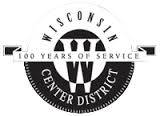
- Under Act 60, the $2 surcharge on all tickets sold at the new arena will be divided between the State and the Wisconsin Center District. “[Twenty-five] percent of the amount received under this section [shall be distributed] to the Department of Administration for deposit into the general fund and [the board of directors] shall retain the remainder for the district.” The proceeds from the $2 surcharge on all tickets sales at the new arena will be used to help the Wisconsin Center District fund their $93 Million contribution.
- The Wisconsin Center District will collect local taxes from “hotel rooms, rental cars, food and beverage” taxes under Act 60 section 70.11(37).
- Wisconsin Senate Bill 209, § 229.445 (2015).
- Rich Kirchen, Assembly Sets Milwaukee Arena Vote for July 28, but What about the Ticket Surcharge?, MILWAUKEE BUSINESS JOURNAL (July 21, 2015), http://www.bizjournals.com/milwaukee/blog/2015/07/assembly-sets-milwaukee-arena-vote-for-july-28-but.html.
- Lee Bergquist & Jason Stein, Scott Walker to Sign Arena Funding Bill Thursday, Journal Sentinel (Aug. 5, 2015), http://www.jsonline.com/news/statepolitics/scott-walker-to-sign-arena-funding-bill-thursday-b99549454z1-320795001.html.
Bucks Lease
Arena Lease, Management and Operations Agreement entered into as of April 13, 2016 between Wisconsin Center District and Deer District, LLC (ArenaCo)
- Publically owned by Wisconsin Center District, but operated by the Milwaukee Bucks.
- Lease payments totaling approximately $45 million during the term of the lease. The initial rent will be $1 million. The rent has escalators ranging from 2-3% over the term of the lease. Rental payments could total as little as $40.6 million to $47.6 million over the 30 year lease term.
- The Bucks bear the responsibility for all operating, maintenance, and capital repair expenses, including an agreement to deposit a cumulative $60 million into a capital improvements fund for the arena over the 30 year term.
- The Bucks will control all revenues from the arena except for events operated by the District.
- The teams revenue will include the arena’s naming right.
- Management control
Management Control Miller Park – Home of the Milwaukee Brewers
Amended and restated Miller Park Lease Agreement by and between Southeast Wisconsin Professional Baseball Park District and Milwaukee Brewers Baseball Club, LP dated June 20, 2004:
Construction Began: 10/96, Opening Date: April, 2000, Capacity: 43,000, Lease Date: 12/31/96
Cost: $322,000,000.00
Rent: Base rent to equal 10% of the Public’s annual bond debt service (less any taxes paid by licensees of skyboxes); lease schedule calculates this to be $900,000 in each of the first ten years, and $1,200,000 in each of the second ten years
Term: 30 years
Team gets 100% of gate, concessions, advertising, naming rights, enhanced seating
Non-Game Events: Team schedules all non-MLB events (subject to Public’s approval) and retains all revenues therefrom
Maintenance: Team’s responsibility, but the Public makes yearly contribution to the Team of the lesser of 64% of “annual actual maintenance costs” or $3,850,000, and the Team is allowed to include its base rent and its $300,000 annual contribution for capital improvements in “annual actual maintenance costs;” net result of all this could be total Public responsibility for maintenance in many of the years during the term of the lease
Capital Improvements: Public puts $700,000 per year and Team puts $300,000 per year into “segregated reserve fund” for capital improvements; beyond this the Public is responsible for all major repairs and improvements.
Parking: Lease is silent on specific parking provisions, but it seems that Team would retain all revenues from any lots or garages on the Ballpark Site.
Cost Overruns
Arena Finance, Funding and Construction Funds Escrow Agreement dated April 13, 2016 by and between the Wisconsin Center District, the City of Milwaukee, and Deer District, LLC
- Paragraph 2.(d) Allocation of Project Costs states: “ArenaCo shall pay or cause to be paid for all Project Costs that exceed the District Commitment, the City Commitment, and the Kohl Commitment. The ArenaCo Commitment is currently estimated to be at least $174,000,000. For the avoidance of doubt, the aggregate of the District Commitment, the City Commitment and the Kohl Commitment (net of any GMF Reimbursed Amount paid by the District and without taking into account any default interest paid with respect to the Kohl Commitment set forth in Section 7.2.3) is the maximum amount of funds required to be contributed by the District (on its own behalf), the City and the District (solely as in its capacity of coordinating the disbarment of the Kohl commitment hereunder), respectively, for Project Costs, without regard to whether total Project Costs exceed the estimate, but subject to Section 11.3 of the Development Agreement.
Non-Relocation Agreement
Per the Team Non-Relocation Agreement between Wisconsin Center District and Milwaukee Bucks, LLC, rec. B, dated April 13, 2016, Section 2.3 Prohibition of Team Relocation:
(a) [Relocation] (i) Relocate, attempt to relocate or permit the relocation of the Team outside the boundaries of the City during the Non-Relocation Term, (ii) change or move the home territory of the Team set forth under NBA Rules in any manner that would exclude the City during the Non-Relocation Term, or (iii) permit or cause to occur any other event that could reasonably be expected to result in the occurrence of an event described in the foregoing clause (i) or (ii).
(b) [Home Games-Away] (i) Enter into any contract that obligates the Team to play Home Games at any location other than the Arena after the Commencement Date or (ii) take any other action that could reasonably be expected to cause the Team’s right to play professional basketball causes or in the Arena after the Commencement Date and for the remainder of the Term to be lost or materially impaired; provided, however, that the foregoing shall not prevent TeamCo or any of its Affiliates from (A) enforcing its rights, and the applicable other party’s obligations, under the Team Agreement, (B) enforcing its rights, and the District’s obligations, under the Arena Agreement, the Finance Agreement and/or the Development Agreement, and (C) taking any action with respect to any strike, lockout, or other labor dispute (provided the Team is not playing Home Games elsewhere during any such period).
(c) [Contravention] Solicit, enter into, or participate in any negotiations or discussions with, or apply for or seek approval from, third parties, including the NBA, with respect to any agreement, legislation, or financing that contemplates, or could reasonably be expected to result in, any action that would contravene or result in contravention of any Non-Relocation Covenant.
The prohibitions set forth in this Section 2.3 shall not apply to TeamCo’s, its Affiliates’ and their respective representatives’ actions, negotiations, discussions, applications, or agreements during the last five Operating Years of the Initial Term with respect to a proposed relocation, change or more that would not take effect during the Term.
The term of the Bucks’ lease is thirty (30) years plus two extensions of five (5) years each, both extensions at the Bucks’ option. Wisconsin Senate Bill, §229.461(3)(a) (2015).
Liquidated damages start at $553 million and de-escalate throughout the term of the lease to $200 million.
The Public-Private Partnership at Work


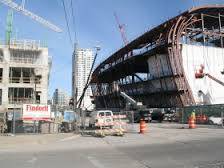


SCR 20: 4.1. Truthfulness in Statements to Others
In the course of representing a client a lawyer shall not knowingly:
(a) make a false statement of material fact or law to a third person; or
(b) fail to disclose a material fact to a third person when disclosure is necessary to avoid assisting a criminal or fraudulent act by a client, unless disclosure is prohibited by Rule 1.6.
Taxpayers Participate in the Cost of Sports Facilities
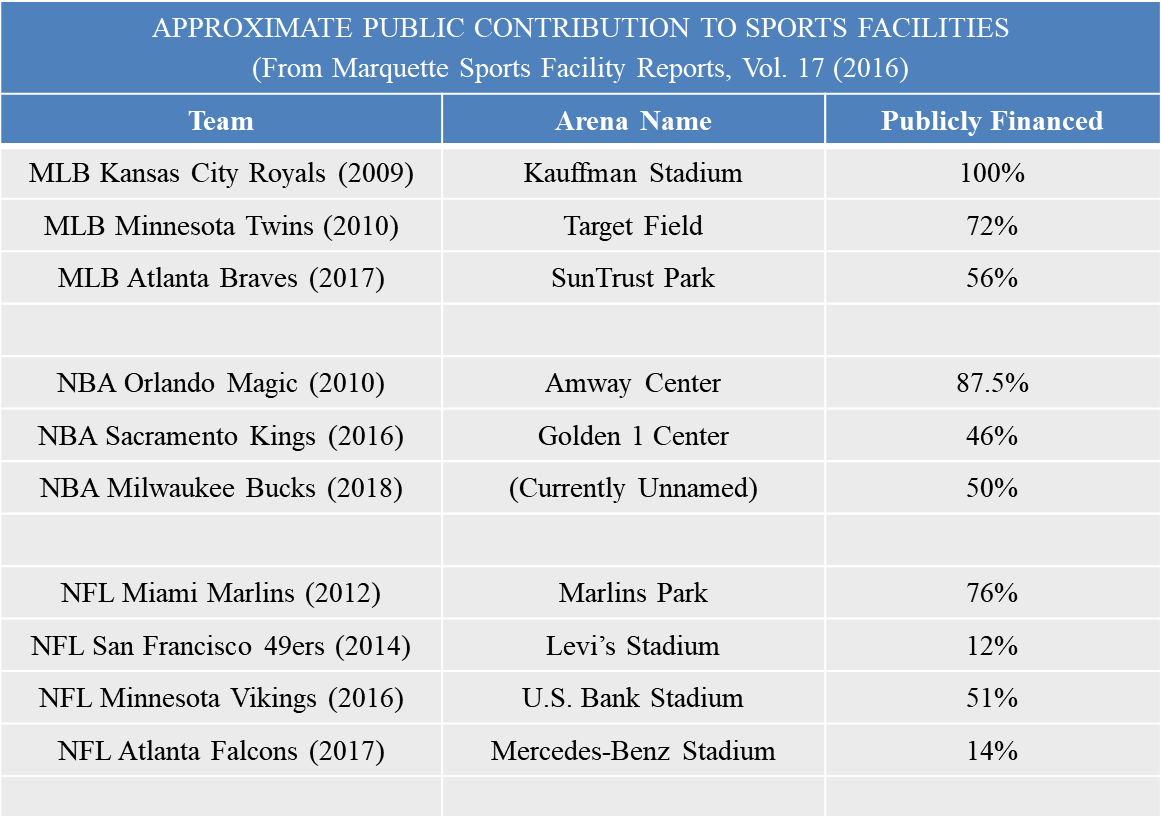
Atlanta Falcons’ Mercedes Benz Stadium

Sports Pork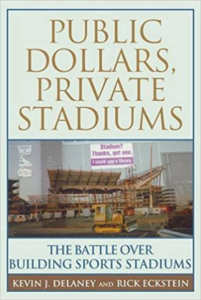
- Sporting facilities financed largely with public dollars (sports pork) are nothing more than a form of public subsidy to benefit private owners and players.
- Public money is converted to private profit.
- Government units throughout the country are mortgaging their future to the sports industry.
- Publicly financed sports facilities over play the actual bottom line and economic impact of dollar flow to the community.
- Stadium proponents always overstate the effectiveness of a stadium as an economic development engine.
- Stadiums, most facilities, simply represent a transference of dollars from one entertainment source to another.
- Facilities do not pay for themselves nor do they act as economic engines.
- Sports facilities result in a generation of annual benefits that are less than the taxpayers actual cost to create and maintain the facility.
- Taxpayers are holding the bag when a facility becomes physically obsolete, economically obsolete, or truly is beyond rehabilitation.
- Public funding of sports facilities only increases capitalized value of team or cash flow of the enterprise.
TAXPAYERS’ BILL OF RIGHTS
- No public funds for any part of a stadium facility;
- No public funds or subsidy for the team franchise;
- No public funds for the purchase and lease-back of land for the benefit of the franchise;
- No expectation that taxpayers should act as a no-cost or low-cost bank for private, fore-profit businesses;
- No recognition, acceptance, or embrace of economic multiplier models which attempt to justify public subsidies of private business arrangements;
- An insistence that the leagues and member teams take full responsibility for their facility financing needs;
- An insistence that any public funds be used solely for infrastructure needs which serve public access, public safety, and/or public health purposes;
- An insistence that nay infrastructure expenditure which primarily or exclusively benefits the individual franchise owners be accompanied by an annual review stream back to the taxpayers in order to help such an expenditure.
Stadiums are a Part of Our Community and Deserve Funding.
- Entertainment value;
- Community pride;
- Business location decisions;
- Value of media exposure;
- Economic impact;
- Fiscal impacts;
- Stimulus to real estate development – Sports.comm; and
- Big League.
Sports.comm
- Sports facility development is nothing more than another form of real estate development.
- Many sports facilities are built in core urban areas that are blighted and are in need of renewal projects.
- Sports facilities attract people, and people enjoy living near sports facilities which results in the generation of residential development along with the creation of other service and commercial needs and opportunities.
- Sports facilities should be the anchor tenant for development districts, a sports.comm, where people live, work, socialize, eat, become educated, shop and congregate.
- Mixed use developments surrounding stadiums will normally include residential development, hotels, auxiliary and entertainment development, services establishments, retail outlets, office space, and potentially some corporate headquarters.
- Sports facility should be part of a planned community
- The planned or happenstance created by sports districts and all benefits associated with them should help ameliorate the controversy surrounding tax payer support for sports facilities.
- It may be that which goes on outside the stadium is more important than what goes on inside.
Titletown District – Green Bay, Wisconsin

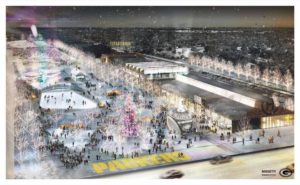

Referendums May Not Necessarily Work.
San Diego Downtown Stadium Initiative
- Should the measure be adopted to: increase San Diego’s hotel occupancy tax by 6% to build a City-owned downtown professional football stadium and convention center project, and fund tourism marketing; effect the project financing, design, construction, use, management, and maintenance, including a $650,000,000 contribution and 30-year commitment by a professional football entity; end Tourism Marketing District assessments; adopt a development ordinance, and related land use, sign, and zoning laws?
Measure C – 100% Precincts reporting
- NO — 56% — 306,887
- YES — 44% — 237,597
Don’t Fund It and They Will Go.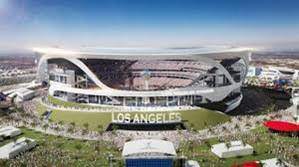
- Oakland Raiders to Las Vegas
- St. Louis Rams to Los Angles
- San Diego Chargers to Los Angeles
Just Say No.
Stadium Debate – True Economic Cost of Stadium Financing
- Bond cost principal
- Interest on bonds
- Capital and maintenance costs
- Infrastructure
- The cost of property tax exemption
- Federal exemption on interest earned from stadium bonds
- State tax exemption on interest earned on stadium bonds
- Sales tax exemption or materials, to name a few
- Sports facility development is a costly undertaking.
Stadium Debate – Municipal Entitlement Fee
- To obtain and maintain sports franchises in any community, governmental units will be required to pay a municipal entitlement or franchise fee.
- A municipal entitlement or franchise fee is a public (taxpayer’s) investment in the form of tax dollars to obtain or maintain a sports franchise.
- A municipal entitlement or franchise fee is usually in the form of the public’s participation in the creation or renovation of a team’s sports facility.
- While the economic benefits generated by sports venues are debatable, the “psychic income” is not, in that new or renovated sports venues fulfill public purposes, produce new tax revenues and media exposure for teams and cities.
Conclusion
- The practice of law in the area of sports facility development is the ultimate in general practice as it involves a multitude of areas of legal specialties.
- Sports is part of the American Dream and part of our daily lives and the industry has grown exponentially and in its complexity. There is a need for competent and ethical legal help.
- A new facility project, such as the arena the Milwaukee Bucks have undertaken, can uplift and change the face of a city.
- Stadiums and arenas are some of the largest public-private partnerships, and the public working with private capital is a necessity in order to get these projects accomplished.
- There will always be a stadium debate and there are two sides to the story and the truth must be told.
